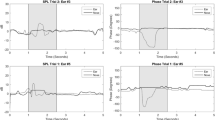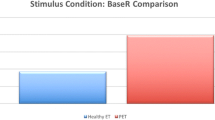Abstract
The aim of this study was the introduction of a specific class of signals, the so-called perfect sequences (PSEQ), in a novel approach for sonotubometry of the Eustachian tube (ET). Sonotubometry using PSEQ stimuli was performed on 20 healthy subjects in order to gauge its potential for clinical applications. In a series of 320 measurements ET opening was probed, which was induced by dry and water swallowing, Toynbee maneuver, and yawning. All sonotubograms were analyzed with respect to their shape, increase of sound intensity, and opening duration. In 298/320 measurements (>93%) the subjects reported subjective ET openings. The evaluation of the recorded sonotubograms showed good detection of ET opening for the inducing maneuvers of swallowing (dry and water swallowing) and the Toynbee maneuver, with 90, 86, and 80% valid sonotubograms, respectively. Yawning led to only 40% valid sonotubograms. In total, 237/320 (~74%) sonotubograms were classified as valid. The evaluation of the sound level increase during ET openings showed that it was significantly higher in measurements with dry and water swallowing, as well as Toynbee maneuvers (mean 17.1, 19.0 and 17.2 dB, respectively), than with yawning (mean 10.17 dB; P < 0.0001). Nasal decongestion was found to have little influence on the results (P > 0.05). Sonotubometry using PSEQ stimuli is a novel sonotubometry methodology that provides valuable information regarding the auditory tube patency. By further technical refinements of the method, a diagnostic tool with high sensitivity and specificity could be developed.








Similar content being viewed by others
References
Honjo I, Kumazawa T, Honda K (1981) Simple impedance test for Eustachian tube function. Arch Otolaryngol 107(4):221–223
McBride TP, Decray C, Cunningham M et al (1988) Evaluation of noninvasive Eustachian tube function tests in normal adults. Laryngoscope 98:655–658
Di Martino E, Thaden R, Krombach GA et al (2004) Eustachian tube function tests. Current knowledge. HNO 52:1029–1040
Di Martino E, Antweiler C, Kellner A et al (2004) Einsatz neuer akustischer Signale zur Tubenfunktionsuntersuchung. HNO Inf 29:104
Di Martino E, Thaden R, Antweiler C et al (2007) Evaluation of Eustachian tube function by sonotubometry: results and reliability of 8 kHz signals in normal subjects. Eur Arch Otorhinolaryngol 264(3):231–236
Virtanen H (1978) Sonotubometry. Acta Otolaryngol 86:93–103
Andreasson L, Ivarson A, Luttrup S et al (1984) Eustachian tube function measured as pressure equilibration and sound transmission capacity. A comparison in healthy ears. J Otorhinolaryngol Relat Spec 46:74–83
Van der Avoort SJ, Heerbeek N, Zielhuis GA et al (2006) Validation of sonotubometry in healthy adults. J Laryngol Otol 120(10):853–856
Murti KG, Stern R, Cantekin E et al (1980) Sonometric evaluation of Eustachian tube function using broadband stimuli. Ann Otol 89:178–184
Palva T, Martilla T, Jauhiainen T (1987) Comparison of pure tone and noise stimuli in sonotubometry. Acta Otolaryngol 103:212–216
Lüke HD (1992) Korrelationssignale. Springer, Berlin
Lüke HD, Schotten HD (1995) Odd-perfect almost binary correlation sequences. IEEE Trans Aerosp Electron Syst 31(1):495–498
Ipatov VP (1979) Ternary sequences with ideal periodic autocorrelation properties. Radio Eng Electron Phys 24:75–79
Antweiler C, Dörbecker M (1994) Perfect sequence excitation of the NLMS algorithm and its application to acoustic echo control. Ann Télécommun 49:386–397
Antweiler C, Antweiler M (1995) System identification with perfect sequences based on the NLMS algorithm. Int J Electron Commun (AEU) 49:129–134
Antweiler C, Telle A, Vary P et al (2006) New otological diagnostic system providing a virtual tube model. In: Proceedings of biomedical circuits and systems conference (BIOCAS). London, Great Britain, pp 21–24
Antweiler C, Vary P, Di Martino E (2006) Virtual time-variant model of the Eustachian tube. In: Proceedings of IEEE International symposium on circuits and systems (ISCAS). Island of Kos, Greece, pp 5559–5562
Van der Avoort SJ, Heerbeek N, Snik AF et al (2007) Reproducibility of sonotubometry as Eustachian tube ventilatory function test in healthy children. Int J Pediatr Otolaryngol 71:291–295
Mondain M, Vidal D, Bouhanna S et al (1997) Monitoring Eustachian tube opening: preliminary results in normal subjects. Laryngoscope 107:1414–1419
Muenker G. (1972). Function analysis of the Eustachian tube. methods and clinic. PhD thesis, University of Freiburg, Germany
Krombach GA, Di Martino E, Nolte-Ernsting C et al (2000) Kernspintomografische Darstellung und Funktionsdiagnostik der Tuba auditiva Eustachii. Rofo Fortschr Geb Rontgenstr Neuen Bildgeb Verfahr 172:748–752
Di Martino E, Walther EL, Westhofen M (2005) Endoscopic examination of the Eustachian tube. A step by step approach. Otol Neurootol 26:1112–1117
Iino Y, Kakizaki K, Saruya S et al (2006) Eustachian tube function in patients with eosinophilic otitis media associated with bronchial asthma evaluated by sonotubometry. Arch Otolaryngol Head Neck Surg 132(10):1109–1114
Takano A, Takahashi H, Hatachi K et al (2007) Ligation of Eustachian tube for intractable patulous Eustachian tube: a preliminary report. Eur Arch Otorhinolaryngol 264(4):353–357
Acknowledgments
Part of this work was supported by the Deutsche Forschungsgemeinschaft (DFG), grant MA 3917/1–1. The authors thank Dr. A. Haselhuhn Aachen University, Institute of Biometrics for the statistics and Mr. C. Miller, Schaumburg, IL, USA for the translation.
Author information
Authors and Affiliations
Corresponding author
Rights and permissions
About this article
Cite this article
Di Martino, E.F.N., Nath, V., Telle, A. et al. Evaluation of Eustachian tube function with perfect sequences: technical realization and first clinical results. Eur Arch Otorhinolaryngol 267, 367–374 (2010). https://doi.org/10.1007/s00405-009-1074-9
Received:
Accepted:
Published:
Issue Date:
DOI: https://doi.org/10.1007/s00405-009-1074-9




